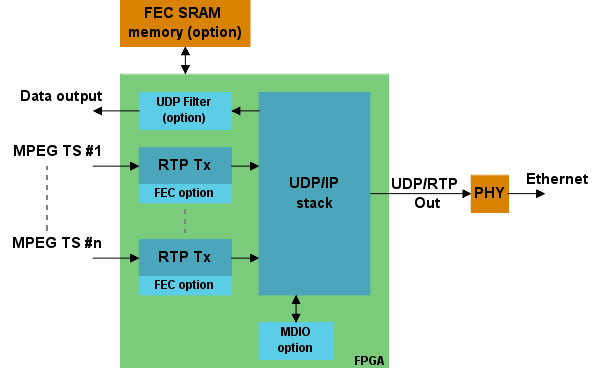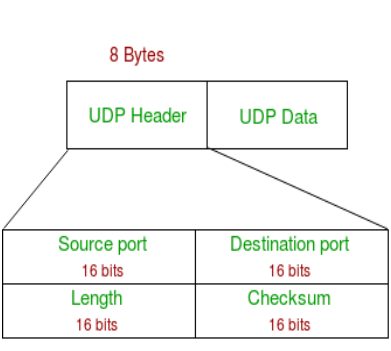UDP (User Datagram Protocol) is a connectionless protocol, while RTP (Real-time Transport Protocol) is used for real-time data delivery. RTP often runs on top of UDP to provide end-to-end network transport functions for applications.
UDP is a simple, fast, and efficient communication protocol. It sends data packets without establishing a connection. This makes it ideal for applications where speed is crucial, like online gaming or video streaming. RTP, on the other hand, is designed for real-time applications.
It provides mechanisms for time-stamping and synchronization of data streams. This makes RTP suitable for audio and video transmission, ensuring timely and ordered delivery. Both protocols play critical roles in networking, but they serve different purposes and complement each other in specific scenarios.
What Is UDP?
User Datagram Protocol (UDP) is a core part of the Internet Protocol Suite. It allows applications to send messages, called datagrams, without establishing a connection. This makes UDP very efficient and fast. It is a lightweight protocol with minimal overhead.
Basic Concept
UDP sends data without ensuring the recipient gets it. There is no handshaking between sender and receiver. This makes UDP faster but less reliable. It does not guarantee delivery, order, or error checking. This can be a drawback for some applications.
Here is a comparison table for a quick overview:
| Feature | UDP |
|---|---|
| Connection | Connectionless |
| Reliability | No guarantee |
| Speed | Fast |
| Overhead | Low |
Common Applications
Many applications use UDP for its speed and simplicity. Here are some common uses:
- Streaming Services: Video and audio streams need fast delivery.
- Online Gaming: Games require quick data transfer with minimal delay.
- DNS Queries: DNS uses UDP for fast lookups.
- VoIP: Voice over IP needs low latency for clear communication.
UDP is ideal for applications where speed is more important than reliability. Understanding its strengths and weaknesses helps in choosing the right protocol for your needs.
What Is RTP?
RTP stands for Real-time Transport Protocol. It is a network protocol for delivering audio and video over IP networks. RTP is used in communication and entertainment systems involving streaming media, such as telephony, video teleconference, and television services.
Basic Concept
RTP works by dividing the data stream into smaller packets. Each packet contains a piece of the media data. These packets are then sent over the network. RTP ensures that the packets arrive in the right order. It also helps to synchronize the data. This is crucial for maintaining the quality of the audio and video.
RTP operates on top of UDP. This means it uses User Datagram Protocol for data transmission. UDP is faster but less reliable than TCP. RTP adds mechanisms to handle the issues of UDP. This includes packet loss and out-of-order delivery.
Common Applications
RTP is widely used in various applications:
- VoIP (Voice over IP): RTP is essential for making phone calls over the internet.
- Video Conferencing: RTP helps in transmitting video and audio in real-time.
- Streaming Services: Platforms like Netflix and YouTube use RTP for live streaming.
Here is a table showing some common uses of RTP:
| Application | Usage |
|---|---|
| VoIP | Internet phone calls |
| Video Conferencing | Online meetings |
| Streaming Services | Live video and audio streaming |
RTP is essential for real-time communication and streaming. Its ability to ensure the correct order and timing of packets makes it a reliable choice.
Key Differences
Understanding the key differences between UDP and RTP is crucial. These protocols serve distinct purposes in network communication. Knowing their unique characteristics will help you choose the right one for your needs.
Protocol Structure
UDP stands for User Datagram Protocol. It is a simpler communication model. It sends messages, called datagrams, without establishing a connection.
RTP stands for Real-time Transport Protocol. It is designed for delivering audio and video over networks. RTP works on top of UDP but adds extra features.
| Feature | UDP | RTP |
|---|---|---|
| Connectionless | Yes | No |
| Header Size | 8 bytes | 12 bytes |
| Real-time Support | No | Yes |
Reliability And Ordering
UDP does not guarantee message delivery. It does not ensure order. Messages may arrive out of sequence.
RTP adds a sequence number to each packet. This ensures packets are processed in order. RTP also supports timestamps for synchronization.
- UDP is unreliable and unordered.
- RTP ensures order with sequence numbers.
- RTP uses timestamps for real-time data.
Choosing the right protocol depends on your needs. For simple, fast communication, UDP is suitable. For real-time applications, RTP is the best choice.
Performance Comparison
Understanding the performance differences between UDP and RTP is crucial. Both protocols serve different purposes and have unique strengths. This section dives into two critical performance aspects: Speed and Latency, and Bandwidth Efficiency.
Speed And Latency
Speed and latency are vital for real-time applications. Here’s how UDP and RTP compare:
| Criteria | UDP | RTP |
|---|---|---|
| Protocol Overhead | Low | Moderate |
| Speed | Very Fast | Fast |
| Latency | Low | Moderate |
UDP is known for its low protocol overhead. This makes it very fast but also less reliable. RTP, while slightly slower, offers more reliability due to additional features.
Bandwidth Efficiency
Bandwidth efficiency is essential for network performance. Let’s compare the two:
- UDP
- High efficiency
- No error correction
- Minimal overhead
- RTP
- Moderate efficiency
- Error correction features
- Additional headers
Although UDP offers high efficiency, it lacks error correction. This means it can transmit data quickly but may lose packets. On the other hand, RTP provides error correction, making it more reliable but slightly less efficient.
Security Considerations
Understanding the security considerations of UDP and RTP is crucial. Both protocols have their own vulnerabilities and mitigation techniques. This section breaks down their security aspects.
Vulnerabilities
Both UDP and RTP have specific vulnerabilities. Let’s explore these in detail.
| Protocol | Vulnerability |
|---|---|
| UDP | Prone to spoofing and amplification attacks. |
| RTP | Susceptible to eavesdropping and tampering. |
UDP does not guarantee delivery, making it less secure. RTP, while built on UDP, adds some security measures but is still vulnerable.
Mitigation Techniques
To secure UDP and RTP, employ various mitigation techniques.
- Use encryption to secure RTP streams.
- Implement firewalls to block malicious UDP traffic.
- Apply authentication mechanisms to verify data sources.
Encryption ensures data remains private. Firewalls filter out harmful traffic. Authentication confirms the identity of data senders.
These techniques enhance the security of UDP and RTP. Applying them mitigates many of the inherent vulnerabilities.

Best Use Cases For Udp
UDP (User Datagram Protocol) is a connectionless protocol. It is ideal for scenarios where speed is crucial. Unlike TCP, UDP does not require a connection to be established before data is sent. This makes it fast and efficient but less reliable. It is perfect for applications where some data loss is acceptable.
Real-time Applications
Real-time applications rely on immediate data transmission. They cannot afford delays caused by error-checking or retransmission. Examples include VoIP (Voice over Internet Protocol) and video conferencing. These applications need to send data swiftly. Any delay can disrupt the communication flow.
Gaming And Streaming
Online gaming and video streaming require quick data transfer. UDP ensures a smooth user experience. In gaming, players need real-time updates. Lag can ruin the gameplay. UDP reduces this lag by sending packets without waiting for acknowledgments.
For video streaming, UDP allows continuous data flow. This is crucial for live broadcasts. Even if some packets are lost, the stream continues without interruptions. This ensures viewers enjoy a seamless experience.
| Application | Why Use UDP? |
|---|---|
| VoIP | Immediate data transmission, minimal delay |
| Video Conferencing | Real-time communication, less focus on error-checking |
| Online Gaming | Low latency, fast data transfer |
| Video Streaming | Continuous data flow, fewer interruptions |
In summary, UDP is best for speed-critical applications. It is less reliable than TCP but faster. This makes it ideal for real-time applications, online gaming, and video streaming.
Best Use Cases For Rtp
The Real-time Transport Protocol (RTP) is vital for multimedia communication. It offers timely delivery of audio and video data. Below are the best use cases for RTP.
Voice And Video Communication
RTP is essential for voice and video communication. It ensures smooth streaming. This protocol supports real-time data transfer. It is widely used in VoIP services.
- Skype uses RTP for reliable voice calls.
- WhatsApp employs RTP for video calls.
- Zoom relies on RTP for seamless video conferences.
RTP handles packet loss and jitter well. This makes it perfect for real-time applications. It provides high-quality audio and video. RTP supports various codecs, enhancing flexibility.
Teleconferencing
Teleconferencing benefits greatly from RTP. It ensures synchronization of audio and video streams. This creates a seamless experience for users. Multiple participants can join without quality loss.
RTP allows for adaptive bitrate streaming. This adjusts the quality based on network conditions. It enhances the user experience. Here are some key features:
| Feature | Benefit |
|---|---|
| Low Latency | Minimizes delays in communication. |
| Error Correction | Reduces packet loss impact. |
| Scalability | Handles multiple users efficiently. |
For teleconferencing, RTP supports encryption. This ensures secure communication. It prevents unauthorized access to streams. RTP is a robust solution for teleconferencing needs.


Frequently Asked Questions
What Is The Main Difference Between Udp And Rtp?
UDP is a simple, connectionless protocol. RTP is built on UDP and adds timing, sequence, and delivery features for real-time applications.
Why Is Rtp Used Over Udp?
RTP is used over UDP for real-time applications. It provides essential features like sequencing, timing, and synchronization, crucial for media streaming.
Is Rtp More Reliable Than Udp?
Yes, RTP is more reliable than UDP. It adds mechanisms like sequencing and time-stamping, which help maintain data integrity and synchronization.
Can Udp Be Used For Real-time Applications?
Yes, UDP can be used for real-time applications. However, it lacks features like sequencing and timing, which RTP provides for better performance.
Conclusion
Choosing between UDP and RTP depends on your application’s needs. UDP offers speed but lacks reliability. RTP ensures timely and ordered delivery, ideal for real-time communication. Both protocols have their strengths. Understanding these can help you make an informed decision for your network requirements.
Choose wisely to optimize performance.



